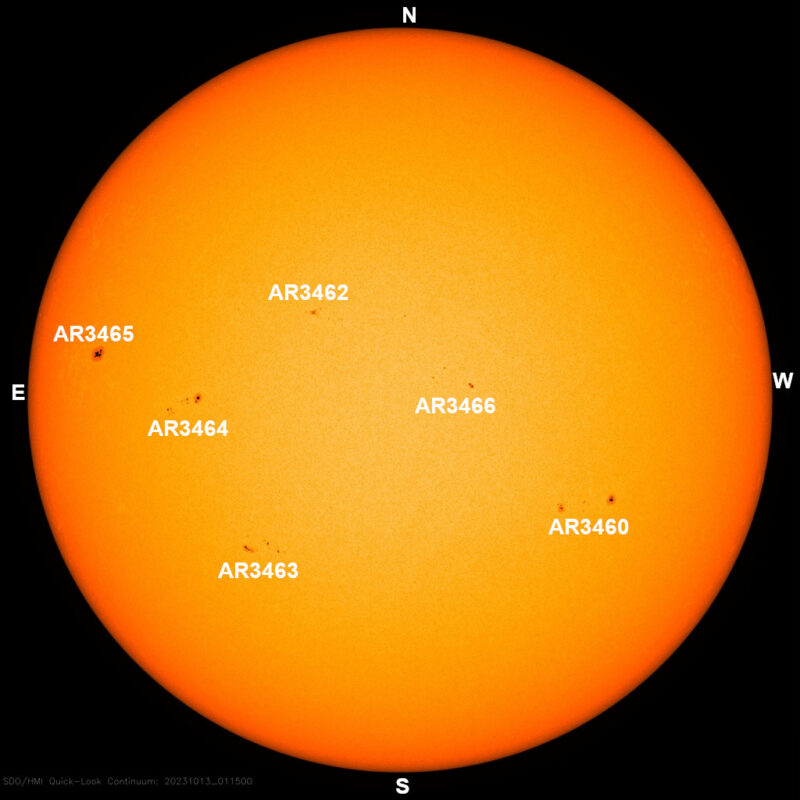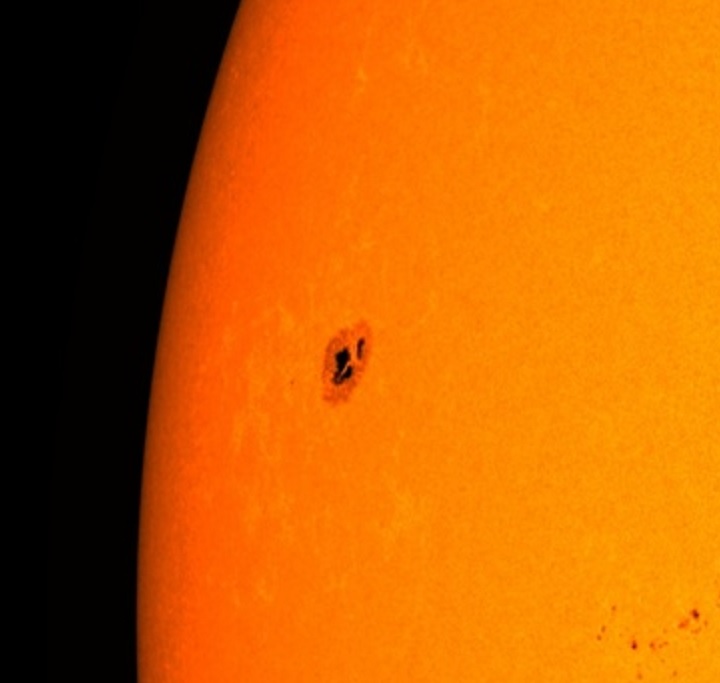
Seeing sunspots during a solar eclipse
Millions will cast their (protected) eyes toward the sun during tomorrow’s solar eclipse. While only those on the path of annularity will be able to see the ring of fire – the outermost layer of the sun in a ring around the moon at mid-eclipse – almost all of North America, and much of South America, will see a partial eclipse. Here’s something fun to try while you’re waiting for maximum eclipse. As the moon is passing in front of the sun, look for sunspots on the unblocked portion of the sun’s surface. Most sunspots are too small to see with ordinary eclipse glasses. But your eclipse glasses will show you a large sunspot. And there’s a good-sized spot near the sun’s east limb now that you can at least try for.
Plus many observers will be watching the eclipse using indirect viewing, or telescopes and binoculars, with special solar filters. No matter how you’re viewing, look at the sun carefully. Do you see any dark spots?
The good news is that the emerging sunspot – labeled AR3465 – will become easier to see from Earth as the sun rotates. So the view on eclipse day (October 14) should be even better than that in the chart at the top of this post.
On this Saturday, as the eclipses progress, observers with solar telescopes will be able to see the moon’s black silhouette reaching and even covering some of the visible sunspots.
The 2024 lunar calendars are here! Best Christmas gifts in the universe! Check ’em out here.

Sunspots are fun
Sunspots are fun to see and contemplate. They are regions of strong magnetic fields on the sun’s surface. They appear dark because they’re cooler (or, perhaps more accurately, less hot) than other parts of the sun’s surface.
An amazing fact is that these dark patches may appear small to you, but they’re usually are a couple of times bigger than Earth’s diameter!
As the images above show, there will be likely be multiple spots on the face of the sun during the October 14, 2023, eclipse. After all, we’re moving toward the peak of the sun’s 11-year cycle of activity. So, on any given day, the sun has spots. The peak of this cycle – known as Cycle 25 – is predicted for the mid-2020s. Sunspots come and go. But they typically last on the order of several earthly days. So the sunspots we’re seeing on the east (left) side of the sun today (October 12) should still be mostly visible during the October 14 eclipse.
Sunspots sometimes emerge into the middle of the sun’s bright disk, too. In other words, they can surprise us! And those that do come into view on the east side of the sun – the side rotating into view of Earth – typically take about 12 days to move across the sun’s visible face, before turning the corner to the sun’s far side.
Sunspots viewed from Mars
The large sunspot in the east (by the arrow in the top image) is one of a few that earthlings have seen recently from another planet. NASA’s Perseverance rover – one of the active rovers currently making its way across the surface of Mars – has a solar filter as part of a filter wheel attached to its mast cameras.
The Perseverance rover on Mars has a different perspective on the sun than we do. That’s because Mars and Earth are currently on nearly opposite sides of the sun from each other. So Mars gets a peek of the activity that’s on the far side of the sun from Earth.

Some thoughts about telescopic filters
Of course, you don’t need to wait for an eclipse to view sunspots. You can view them whenever they’re visible on the sun (and again they’re going to be very visible over the next few years, as we reach solar maximum) … assuming you’re using protective filters.
The most popular and affordable solar filters for telescopes are the white light filters, which provide nice views of sunspots. Some with higher resolution will clearly show other features on the sun’s surface, including faculae – bright areas with a white appearance – which are also magnetically strong fields, although less concentrated than in sunspots.
Hydrogen alpha filters or Ha telescopes, while more expensive, show amazing views of solar prominences that look like flames on the sun’s edge. Those will also provide a nice twist to the solar eclipse, showing the moon’s dark disk close to the prominences.
If you didn’t pick up a solar filter or a pair of solar binoculars in time for this eclipse, there’s another one on the way for North America! Plan now and you can be stocked up in time for the total solar eclipse on April 8, 2024.
Bottom line: If you’re watching the annular or partial solar eclipse on October 14, 2023, with safe filters, look for sunspots around the disk of the dark moon.











